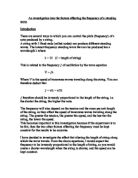refraction experiment
REFRACTION EXPERIMENT Aim: To study the phenomenon of refraction of light by using a glass block. Theory: Light is one of the most fundamental energy forms and an understanding of several of its properties is essential to any understanding of science. In this investigation we would be seeing the different phenomenon of refraction of light. Refraction is a change in the direction of radiation that occurs when it crosses the interface between two media in which the radiation travels with different speeds. The radiation undergoes a change in speed, in wavelength, and in direction. These are a few common terms in relation to refraction of light: > Reflection: the process by which radiation that strikes a surface separating two media of different densities is in part or in whole turned back into the medium from which it originated. The radiation rebounds from a barrier in its path without a change in speed. > Normal line: A line perpendicular to the surface at the point where a ray of light strikes. > Incident Ray: A ray which impinges upon a surface. > Refracted Ray: a ray that has changed direction after crossing from one media to another, in which the speed is different. > Emergent ray: the light ray leaving a medium in contrast to the entering or incident ray. > Angle of incidence: the angle between the incident ray and a normal. > Angle of refraction: the angle
Are mobile phones dangerous? Research Project.
Are Mobile Phones Dangerous? Introduction I am looking at ‘Are mobile phones dangerous?’ The case study has some relevance to the current news topics because the findings have been made public and people are always asking ‘are there any risks’, as you will find out there are many theories and supposed evidence, that may or may not be reliable. In this study I will be looking for a correlation between mobile phone usage and fertility in men, increased risk of brain tumours and other negative side effects such as concentration levels. Background information: (information from http://www.vodafone.com.au/personal/aboutvodafone/healthmobilephonetechnology/howdoesthemobilephonesystemwork/index.htm ) Mobile phones use radio waves however some have a higher frequency so can be classed as microwaves. Radio waves are used for communication. Long wave radio has lengths of about 1km. Mobile telephones are two-way radios. When you talk into a mobile telephone, it picks up your voice and converts the sound to radiofrequency energy (or radio waves). The radio waves travel through the air until they reach a receiver at a nearby base station. The base station then sends your call through the telephone network until it reaches the person you are calling. When you receive a call on















